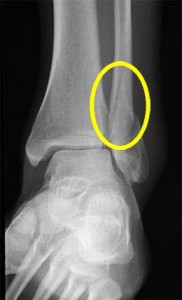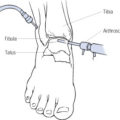*This page may contain affiliate links. When you buy through these links, we may earn a small commission at no extra cost to you.
Fractures can happen with any bones in the human body. But there are certain areas that get fractured very often. One such area is the ankle joint.

Legs are the main organ that helps us implement many daily activities like sitting, standing, walking, climbing, running, jogging, etc.
Even the whole body’s weight is balanced properly and evenly by the two legs only.
Whenever the legs are strained a lot or given extra workload, then it will get one or the other problem.
One such issue is an ankle fracture, where the ankle joint bones will get cracked partially or completely.
A broken ankle or an ankle fracture is a severe painful injury. It causes tremendous ankle pain and discomfort to the sufferer and restricts his or her mobility.
Even small things like- dropping something on your foot, taking any wrong step, twisting, or rolling over onto your ankle can cause the ankle to fracture.
Even auto accidents can sometimes lead to a broken ankle problem.
All those who are osteoporotic or obese are at greater risk of a broken ankle problem.
Also, people who participate in high-impact sporting activities or use poorly manufactured exercise equipment may suffer from this medical condition a greater amount.
Ankle Fracture Types
The ankle joint is made up of three different bones. These are:
- Tibia, the shin bone,
- Fibula, the smaller lower leg bone, and
- The talus, the small bone which helps in communicating the tibia and fibula with the heel bone calcaneus
Around these bones, various ligaments and muscles were present which helps in the proper functioning of the ankle joint to move freely according to the anatomical movement of the legs.
When heavy stress or unwanted pressure is applied to any of these bones, then it may cause a fracture of the ankle joint, which is normally called an ankle fracture.
Medically the ankle fracture is classified into various types according to the fracture site.
If the fracture happens at the end of the fibular bone, then it is termed a lateral malleolus fracture, and if the tibia and fibula are broken, then it is termed a bimalleolar fracture.
Generally, in the case of a broken ankle, two anatomical joints will get involved, one is the ankle joint where the tibia, talus, and fibula meet together, and the other is the syndesmosis joint which is formed by the tibia and fibula along with tight ligament bands.
Causes of Broken Ankle and Diagnosis
The term broken ankle explains a simple hairline fracture or even complicated multiple fractures.
In the case of a simple fracture of the ankle joint, the management and cure are much easier, and the person also will get a speedy recovery, whereas, in the case of multiple fractures the recovery will take much time till then, the person should be in bed only.
The broken ankle problem comes with any group regardless of sex.
But in recent decades the incidence of broken ankles has been seen higher in the aged community because of calcium and Vitamin-D deficiency due to lack of bodily hormones like sex hormones and thyroid.
- Unnatural twisting or rotation of the ankle joint,
- Fall from a huge height,
- A pressure injury, and
- Impact injury during any accidents, etc.
Most of the time, diagnosing a problem correctly pays a perfect way for the management or treatment of a particular problem.
Thus diagnosing the ankle fracture gives good results of improvement.
For ankle fracture diagnosis, the general and major diagnostic modalities used are as follows:
- Taking the patient’s complete medical history gives maximum confirmation regarding the problem. Hence taking proper case history is highly important.
- Followed by the proper case history, the perfect physical examination gives confirmation regarding the concerned problem furthermore.
- Only after thorough case history and physical examination do the other diagnostic methods and imaging techniques come in the queue like X-rays, MRI, CT Scan, Stress tests, etc.
What are The Broken Ankle Symptoms?
Check out different symptoms of the broken ankle to get more knowledge on the topic.
Ankle Pain:
This is one of the most prominent symptoms of a broken ankle.
Just like breaking any bone in the body, breaking bones in the ankle is very painful.
Bruising:
When blood gets collected in the surrounding tissues of the affected area after an injury, especially a fracture, it leads to bruising.
As blood profuse out from the injured area or surrounding soft tissues, it passes towards superficial layers of your skin.
After accumulating outside the vascular system, blood cells lose oxygen and become dark in color.
Blood vessels acquire blue or purple hues due to inadequate blood in the tissue.
Swelling:
When the problem of a broken ankle occurs, it may also affect the surrounding tissues such as muscles, tendons, and ligaments.
When these structures get badly affected, they bleed profusely. The blood comes out of bone marrow as well due to injury.
It thus causes noteworthy swelling not only in the affected area but also in the area surrounding the injury.
Deformity:
The significant types of injuries can cause some level of deformity in an ankle bone.
The ankle is regarded as a stable joint, but when it gets broken from both sides, it may become de-stabilized and slip from its original position, thus causing deformity.
Deformity in any form can badly disrupt the blood supply to the foot and toe area of the body.
Remember that restoration of alignment is important to prevent any kind of permanent vascular damage.
It is very important to note these broken ankle symptoms so that due medical attention can be taken on time for early healing of a broken ankle.
Management of Broken Ankle and Best Treatment Options
RICE therapy is the first aid protocol for a broken ankle.
- R – Rice
- I – Ice massage
- C – Compress
- E – Elevation
Followed by the RICE therapy, the patient’s ankle joint will be applied with POP (Plaster of Paris).
The POP keeps the joint stable, and it provides good rest to the ankle joint without any further movements in it.
The POP should be kept for at least 30 to 45 days, depending on the fracture grade.
Application of ice or heating pads and non-steroidal inflammatory drugs such as acetaminophen or ibuprofen also help wonderfully in getting relief from the painful condition of a fractured ankle.
Additionally, exercise is the main element of ankle rehabilitation, as it improves the motion and strength of the ankle to some range.
You should, therefore, not forget it if you want to reduce your fractured ankle healing time.
Using fractured ankle boot and ankle brace after a broken ankle is also recommended by experts in many cases.
Using these ankle brace support stabilizers can effectively help heal the ankle fast and prevent the rolling of the ankle.
If at all the fracture is severe, then a surgical process known as an open reduction internal fixation procedure is performed to line up the broken bones and place them in order with screws and metal rods.
Physical Therapy For Ankle Fracture: Does It Help?
When you are going with the treatment for an ankle fracture, your physician can also help to reduce the pain and recover from the fractured ankle.
Following the fractured ankle recovery tips given by the physical therapist actually helps to heal the broken bones fast and permits normal healing.
You are advised to learn the way to use helpful devices like a cane, a walker, a fracture boot, crutches, etc by the physical therapist.
Besides this, gentle and effective exercises for the muscles of the hip and knee are recommended and performed in order to assure that the group of muscles helps you to walk properly and not get too feeble due to lack of exercise.
After the ankle is healed, the physician advises removing the cast and permitting you to walk with a weight on your ankle.
However, you will use a helpful device like crutches or a quad cane to walk normally.
Here, your experienced physical therapist will completely assess your ankle for further treatment. And if required, recommend the best plan for recovering your ankle completely.
Make sure to follow the physical therapist’s advice as it helps you slowly walk independently without any help or support.
Other Related Questions:
How long does it take to recover a broken ankle?
It may take around 6-12 weeks to heal your broken ankle completely.
Trainers and podiatrists usually recommend resuming daily activities after these three months.
In a few severe cases, it may take several additional months to regain complete strength and mobility.
When should you put weight again on a broken ankle?
Depending on the type of fracture and its severity, it may take more than six weeks before you can put any weight on your legs.
Walking would be fine but running and performing high-impact exercises or training should be done after 12 weeks.
Getting the green signal from your doctor is also highly recommended.
Will you need to use crutches after ankle surgery?
It’s good to use crutches or some other alternative (such as a knee walker or a wheelchair) for at least six weeks.
This will help avoid any extra weight that can be put on your feet.
Incoming search terms:- broken ankle pictures
- broken ankle
- symptoms of a broken ankle







